DAY #1 - PARIS - the City of Lights!
Thursday, Oct. 17th

Arrive in Paris, leave bags at Hotel and be ready to
tour by 10 am?
*Place de la Concorde:
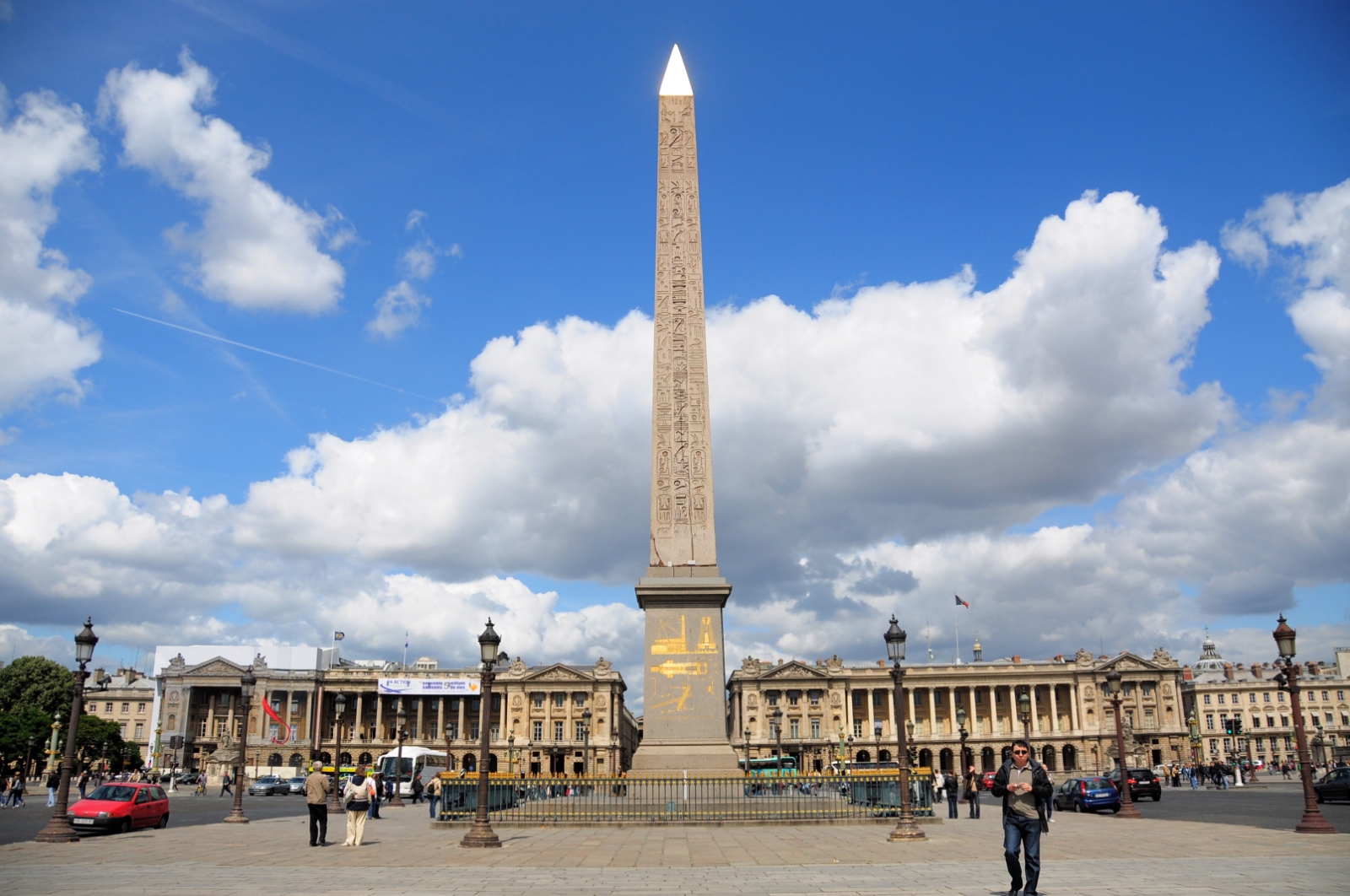
The city's largest public square has a lengthy history as well. During the French Revolution in 1789, the statue of Louis XV of France was torn down
and the area renamed the Place de la Revolution. The new revolutionary government erected a guillotine in the square and it was here that King Louis XVI was executed on 21 January 1793,. Other important figures guillotined on the site, often in front of cheering crowds, were Marie Antoinette, Madame du Barry, Robespierre a leader in the revolution! In 1795 under the Directory, the square was renamed Place de la Concorde as a gesture of reconciliation.
The center of the Place is occupied by a giant Egyptian obelisk decorated with hieroglyphics exalting the reign of the pharaoh Ramesses II. It is one of two the Egyptian government gave to the French in the 19th century. The other one stayed in Egypt, too difficult and heavy to move to France with the technology at that time. In the 1990's President Mitterrand gave the 2nd obelisk back to the Egyptians. The 3300-year-old obelisk once marked the entrance to the Luxor Temple. in Egypt.
*Stroll up the Champs Elysees to the Arch de Triumphe:

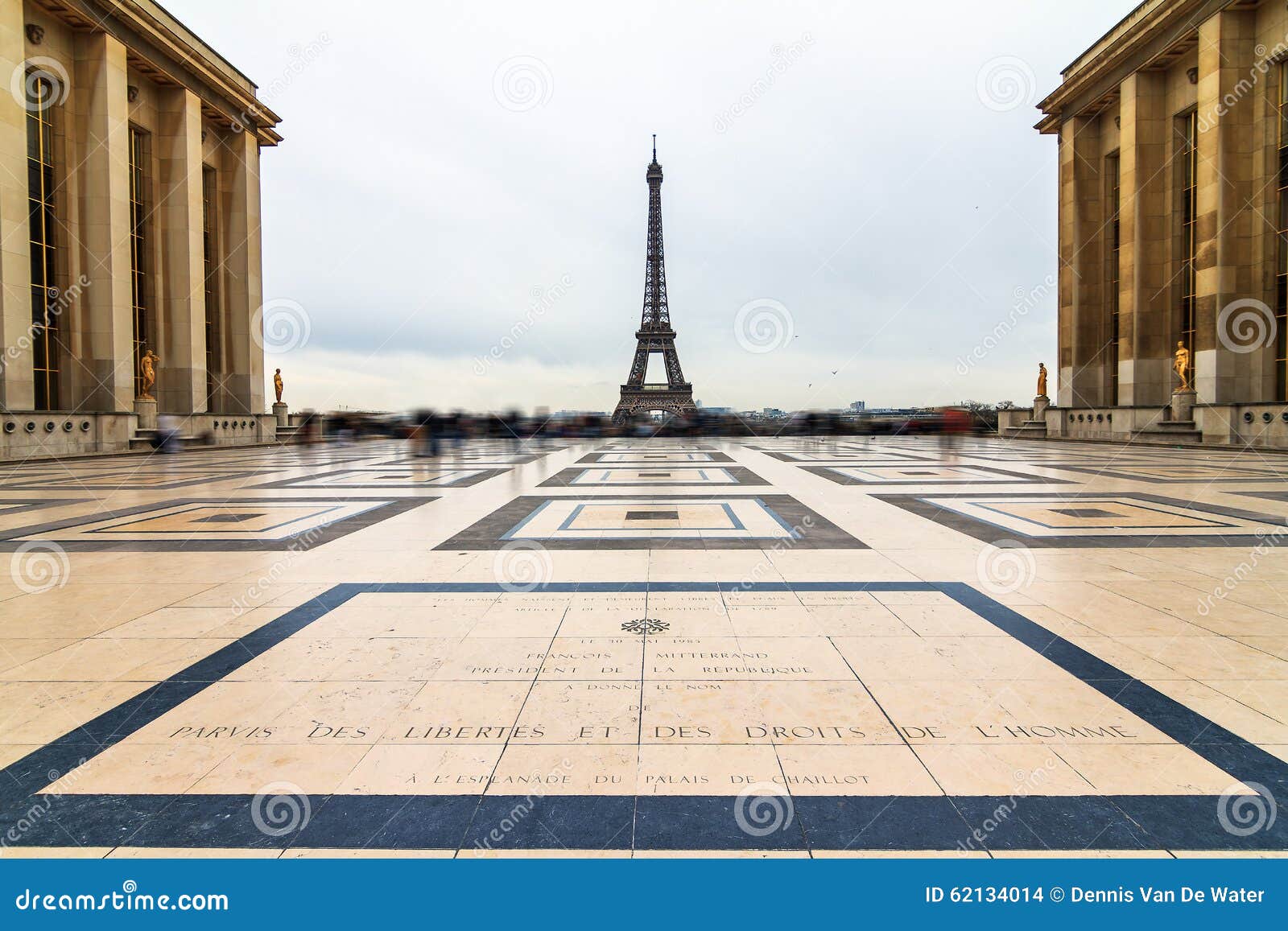
This is why you came to Paris, isn't it - to see the Eiffel Tower and this is the best spot from which to take a picture of the Tower - you may very well recognize the perspective from various movies you've seen. The Trocadéro, site of the Palais de Chaillot, sits across the Seine from the Eiffel Tower. It is also the name of the 1878 palace which was demolished in 1937 to make way for the Palais de Chaillo.[1] The hill of the Trocadéro is the hill of Chaillot, a former village. The large plaza at Place de Trocadéro is a popular tourist destination to take pictures of the Eiffel Tower.
*Musee d'Orsay:
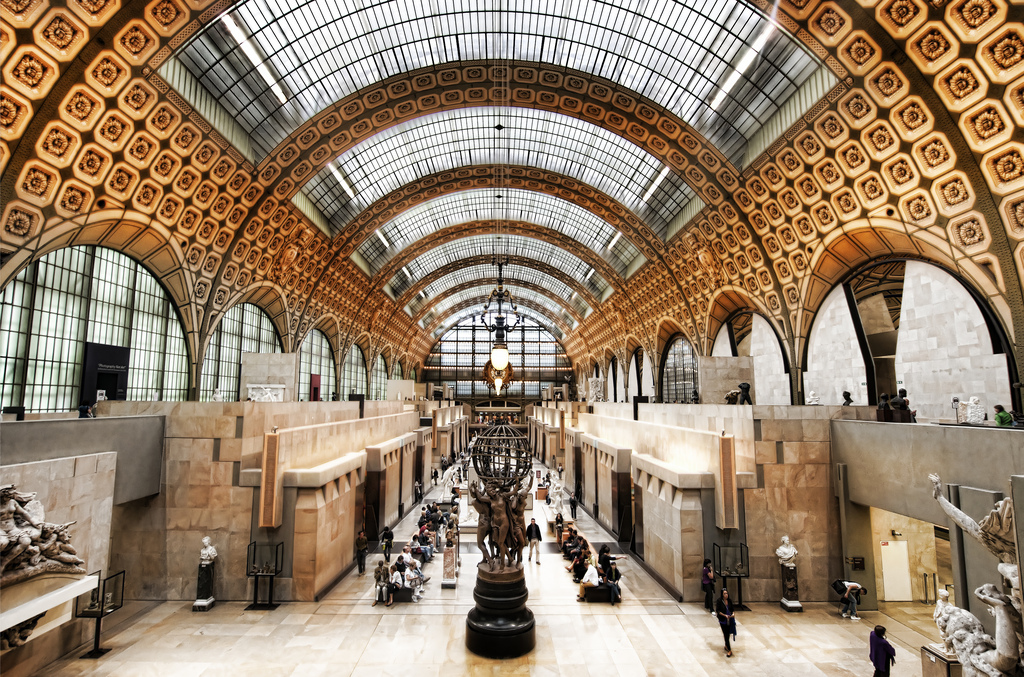
This beautiful museum, once a railroad station, now houses a
staggering collection of impressionist art including Van Gogh's
"Starry Night", some Rodin sculptures and works by Degas,
Manet, Monet, Renoir, Seurat among many others.
Built in only two years for the 1900 Universelle Expo, it was
only a train station until 1939. During WWII it was the postal
depot for POWs. The western facade, where the museum's
current entrance is, was a hotel for a long time. During each of
these incarnations, the building was frequently at risk of being
destroyed with many a valiant preservationist fighting
developers tooth and nail. Finally in 1986 Mitterand bought it
in order to showcase the art, chronologically, where the Louvre
lets off in the middle-19th century. In order to hold to our credo
- an hour in a museum is long enough to see the top sites
without sacrificing your legs and your energy for the rest of the
day - we will focus on the top sites!
*Eiffel Tower & Boat Cruise on the Seine River:

*Seine River Cruise:
*Dinner together on the Champs Elysees or near
Notre Dame
DAY #2 - MORE PARIS - The City that
Never Sleeps (but we hope you do!)
*Fontainebleau Palace:

*Pere - Lachaise:
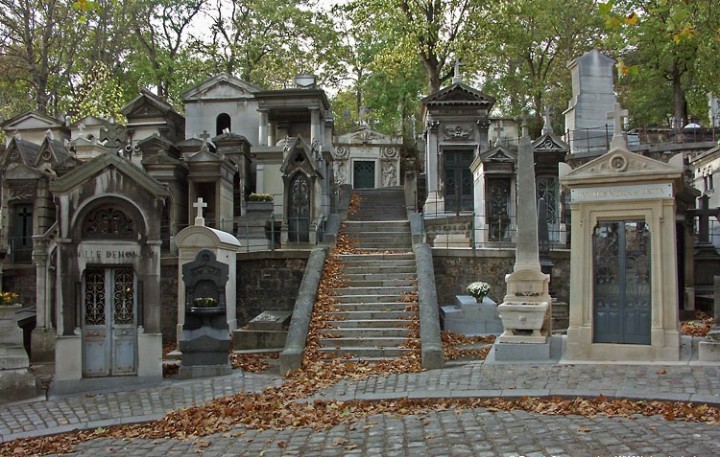
*Notre Dame Cathedral:


*Sainte Chapelle:

This is our very favorite - floor to ceiling stained glass
windows of incredible, detailed beauty - especially on a sunny day!
Sainte Chapelle, located just around the corner from Notre Dame
on the Isle de Cite was built in seven years and completed in 1248,
as part of the Palace complex of French kings until the 14th century.
It's original function was to house precious Christian relics,
including Christ's crown of thorns, acquired by Saint Louis.
Having these sacred relics in his possession made the already
powerful monarch head of western Christianity.
Stunning stained glass is featured in this church which is
considered among the highest achievements of the Rayonnant
period of Gothic architecture. The glass is arranged across 15
windows, each 15 meters high, the stained glass panels depict
1,113 scenes from the Old and New Testaments recounting the
history of the world until the arrival of the relics in Paris.
*Louvre Museum:

You've been waiting for this one, right! Thanks to the late
hours on Friday, you will have plenty of time to explore some of
the most famous pieces of art in the world housed inside the
Louvre Museum. We'll lead you around to the highlights or
you can explore with a map at your leisure!
Originally a fortress built in the 1100's, the Louvre became a
palatial residence under Louis the 1st and remained so until Louis
the 14th moved the royal residence to Versailles. It was to the
Tuileries Palace, adjacent to the Louvre, that Louis the 16th and
Marie Antoinette were sent after being arrested during the French
revolution.
In the intervening years, the museum was used for various
art academies and later under Napoleon was restored and
renovated to serve as a museum in his efforts to collect and display
art pieces from around the world, captured in his military
campaigns, through private donations and commissions. Aptly
named, "Musee Napoleon", Napoleon is credited with creating the
foundation for the museum as it is today - the largest in the world -
with a space of over 800,000 square feet and over 38,000
collection pieces. If we see 10 of them we will be doing well!
Museum Highlights Include:


Winged Victory Mona Lisa

Venus de Milo
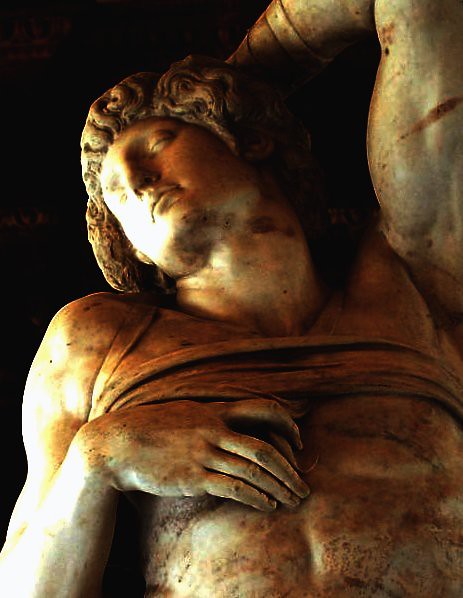
Michaelangelo's Slave
Overnight in Paris
DAY #3 - Alsace Region, Saturday, Oct. 19th
Depart Paris via Train (TGV) - early
Arrive in Strasbourg: Visit City Highlights
*Notre Dame Cathedral:
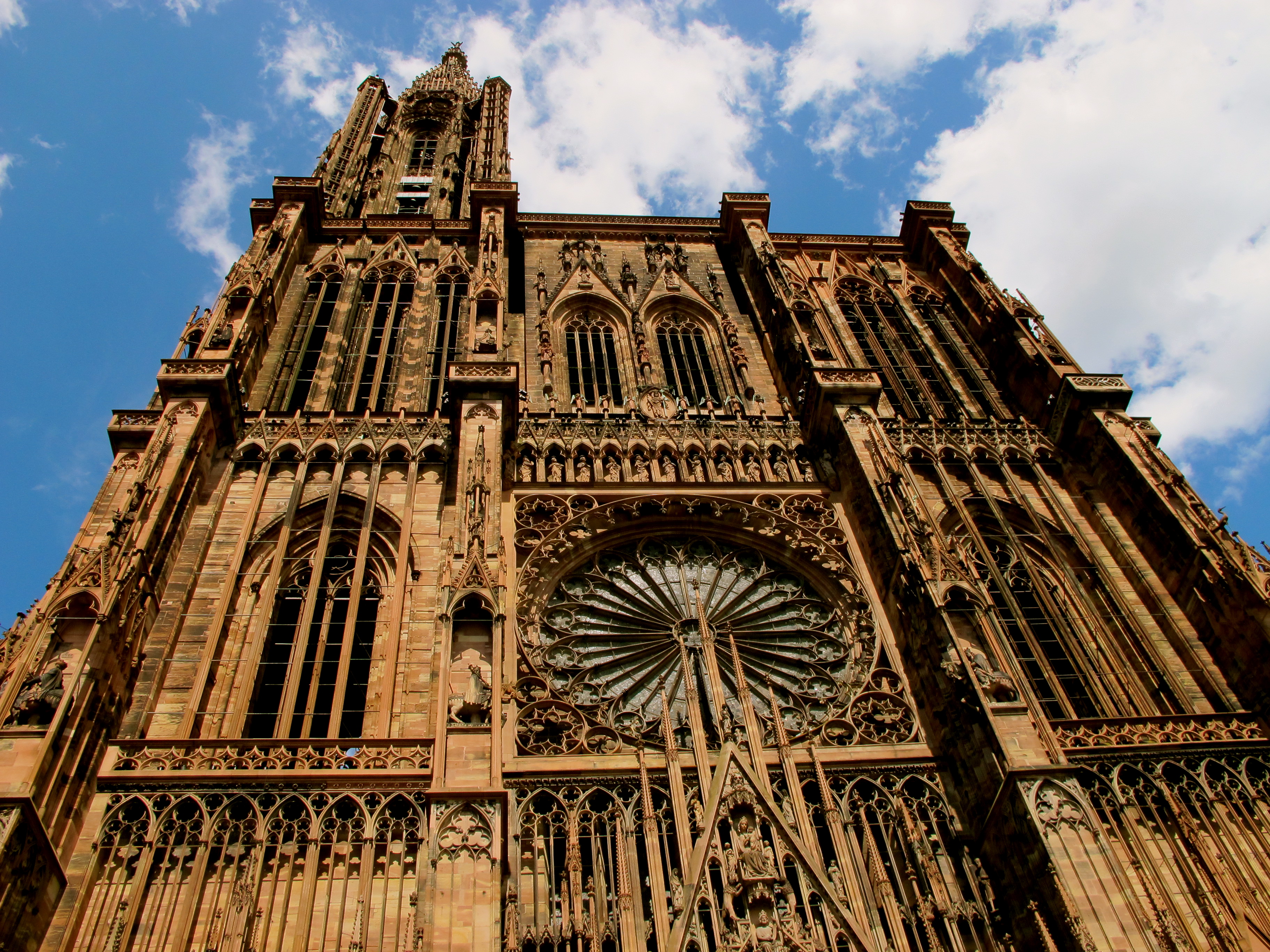
*Strasbourg Cathedral (Notre Dame):…also known as Strasbourg Minster, is a Roman Catholic cathedral. Although considerable parts of it are still in earlier Romanesque architecture, it is widely considered to be among the finest examples of high, or late, Gothic architecture. Erwin von Steinbach is credited for major contributions from 1277 to his death in 1318.
*Stroll through Little France Quarter:

*Maison Du Fromage: (The Cheese House)

Dinner & Overnight in Colmar:
Hotel Turenne: http://www.turenne.com/en/
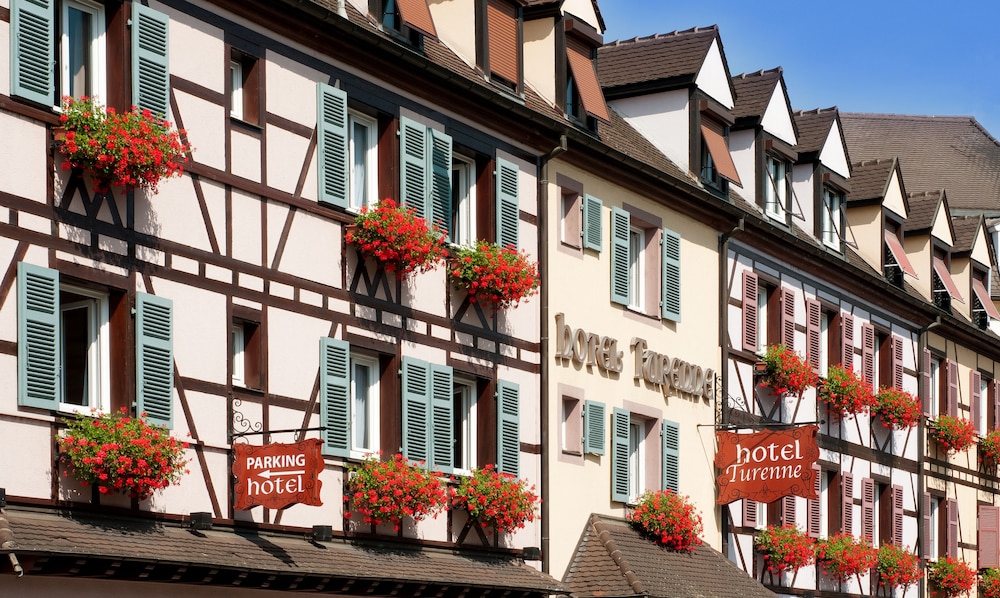
Day #4 - Sunday, Oct. 20th No Sass, Alsace!
*Church at Branch at Colmar:

DAY #9 - Friday, Oct. 25th, Bretagne:
Couldn't resist so just a bit more Brit!
*Mont St. Michel:
...is an island at the mouth of the Couesnon River. As of 2015
it had a population of 50. The island has held strategic fortifi-
cations since ancient times and since the 700s has been the seat
of the monastery from which it draws its name. The structural
composition of the town exemplifies the feudal society that
constructed it: on top, God, the abbey and monastery: below
the great halls; then stores and houses; and at the bottom,
outside the walls, houses for fishermen and farmers.
The commune's position, on an island just a few hundred
meters from land, made it accessible at low tide to the many
pilgrims to its abbey, but defensible as an incoming tide
stranded, drove off, or drowned would-be assailants. The
mount remained unconquered during the Hundred Year's
War. Louis the XI turned the Mount into a prison. There-
after the abbey began to be used regularly as a jail before the
revolution.
One of my favorite sites to visit in France, it appears through
the water's mist like a miraged castle. The hike up the narrow
lanes are challenging, but I managed it during a ferocious bout
of morning sickness many years ago, determined not to miss
out! So glad to see it again with a calmer stomach but a slower
gait. Truly an amazing place to visit!
Mont St. Michel

Saint-Lo: Picnic Lunch
The city has long been an important center of the eco-
nomy of Nomandy. It has been coveted by neighboring
nations, including England, resulting in many successive
invasions. It lost its dominant position towards the end of
the 1800s because it failed to take advantage of the first
Industrial Revolution, which instead affected much of the
predominantly peasant population. Originally called
Briovere (meaning "Bridge on the Vire River" in Gaulish)
the town is built on and around ramparts. The town
started life as a Gallic fortified settlement, but was con-
quered by the Romans in 56 BC.
The Battle of Saint-Lo is one of the 3 conflicts in the Battle
of the Hedgerows which took place in July 1944, just before
Operation Cobra. Saint-Lo had fallen to Germany in 1940
and after the invasion of Normandy, the US targeted the city
as it served as a strategic crossroads. American bombard-
ments caused heavy damage (up to 95% of the city was
destroyed) with a high number of casualties, which resulted
the martyred city being called "The Capital of Ruins."
From this photo you can see the catastrophic damage the
city sustained in WWII. The city was not rebuilt, but the
rubble cleared away and new structures built. None of the
charming half-beamed building of cities such as Dinan
which were not bombed.
Saint-Lo WWII Destruction

D-day Sites:
*Pointe de Hoc:
...is a promontory with a 100 ft. cliff overlooking the English
channel n the northwestern coast of Normandy. During WWII
it was the highest point between Utah Beach to the west and
Omaha Beach to the east. The Germany army fortified the area
concrete casemates and gun pits. On D-Day, the U.S. Army Ranger
Assault Group captured Pointe de Hoc after scaling the cliffs.
Here we can visit the German bunkers used during the invasion.
Pointe de Hoc
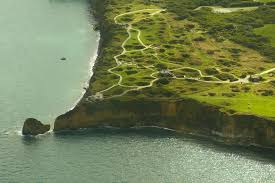
*WWII U.S. Cemetery
On June 8, 1944, the US First Army established the temporary
cemetery, the 1st American cemetery on European soil in WW II.
After the war, the present-day cemetery was established a short
distance to the east of the original site. It is located on a bluff over-
looking Omaha Beach and the English Channel. France has
granted the US a special, perpetual concession to the land
occupied by the cemetery, free from any charge or tax to
honor the forces. The cemetery is managed by the
American Battle Monuments Commission, a small
independent agency of the US federal government. The US
flag flies over these granted soils.
The cemetery site, at the north end of a half mile access road
covers 172 acres and contains the graves of 9.385 of our military
dead, most of whom lost their lives in the D-Day landings and
ensuing operations. Included are graves of Army Air Corps crews
shot down over France as early as 1942 and 3 American women.
A new $30 million visitor center was dedicated in 2007. In
addition to exhibits, the center includes 3 informational visitor
films.
US WWII Cemetery, Normandy

*Omaha Beach:
(From Wikipedia) Omaha Beach was the code name for one of the
five sectors of the Allied invasion of German-occupied France in
the Normandy landings on June 6, 1944, during World War II.
'Omaha' refers to a section of the coast of Normandy, France,
facing the English Channel 8 kilometers (5 mi) long, from east of
Sainte-Honorine-des-Pertes to west of Vierville-sur-Mer on the
right bank of the Douve River estuary and an estimated 150-foot
(45 m) tall cliffs. Landings here were necessary to link the British
landings to the east at Gold with the American landing to the west
at Utah, thus providing a continuous lodgement on the Normandy
coast of the Bay of the Seine. Taking Omaha was to be the respon-
sibility of United States Army troops, with sea transport, mine
sweeping, and a naval bombardment force provided predomi-
nantly by the U. S. Navy and Coast Guard, with contributions
from the British, Canadian, and Free French navies.
The primary objective at Omaha was to secure a beachhead of
eight kilometres (5.0 miles) depth, between Port-en-Bessin and the
Vire River, linking with the British landings at Gold to the east, and
reaching the area of Isigny to the west to link up with VII Corps
landing at Utah. Opposing the landings was the German 352nd
Infantry Division. Of the 12,020 men of the division, 6,800 were
experienced combat troops, detailed to defend a 53-kilometer
(33 mi) front. The German strategy was based on defeating any
seaborne assault at the water line, and the defenses were mainly
deployed in strongpoints along the coast. The untested American
29th Infantry Division, along with nine companies of U.S. Army
Rangers redirected from Pointe du Hoc, assaulted the western half
of the beach. The battle-hardened 1st Infantry Division was given the
eastern half. The initial assault waves, consisting of tanks, infantry,
and combat engineer forces, were carefully planned to reduce the
coastal defenses and allow the larger ships of the follow-up waves
to land.
Very little went as planned during the landing at Omaha. Difficul-
ties in navigation caused the majority of landing craft to miss their
targets throughout the day. the defenses were unexpectedly strong,
and inflicted heavy casualties on landing U.S. troops. Under heavy
fire, the engineers struggled to clear the beach obstacles, later
landings bunched up around the few channels that were cleared.
Weakened by the casualties taken just in landing, the surviving
assault troops could not clear the heavily defended exits off the
beach. This caused further problems and consequent delays for
later landings. Small penetrations were eventually achieved by
groups of survivors making improvised assaults, scaling the bluffs
between the most heavily defended points. By the end of the day,
two small isolated footholds had been won, which were subsequently
exploited against weaker defenses further inland, thus achieving the
original D-Day objectives over the following days.
Omaha Beach - then.... and now


*Bayeux Tapestry:
The Bayeux Tapestry (actually an embroidery) is an
embroidered cloth nearly 230 ft. long and 20 inches tall.
which depicts the events leading up to the Norman
conquest of England involving William the Duke of
Normandy (the Conqueror) and Harold, Earl of Wessex,
later King of England, and culminating in the Battle of
Hastings. It is thought to date to the 11th century, within
a few years after the battle. It tells the story from the
point of view of the conquering Normans but is now
agreed to have been made in England.
According to Sylvette Lemagnen, conservator of the
tapestry, "the tapestry is one of the supreme
achievements of the Norman Romanesque....its
survival almost intact over nine centuries is little short
of miraculous...its exceptional length, the harmony
and freshness of its colors, its exquisite workmanship,
and the genius of its guiding spirit combine to make it
endlessly fascinating."
The cloth consists of some 50 scenes with Latin,
embroidered on linen with colored woolen yarns. It is
likely that is was commissioned by Bishop Odo,
William's half-brother and made in England - not
Bayeux - in the 1070s. In 1729 it was rediscovered by
scholars at a time when it was being displayed annually
in Bayeux Cathedral.
Bayeux Tapestry
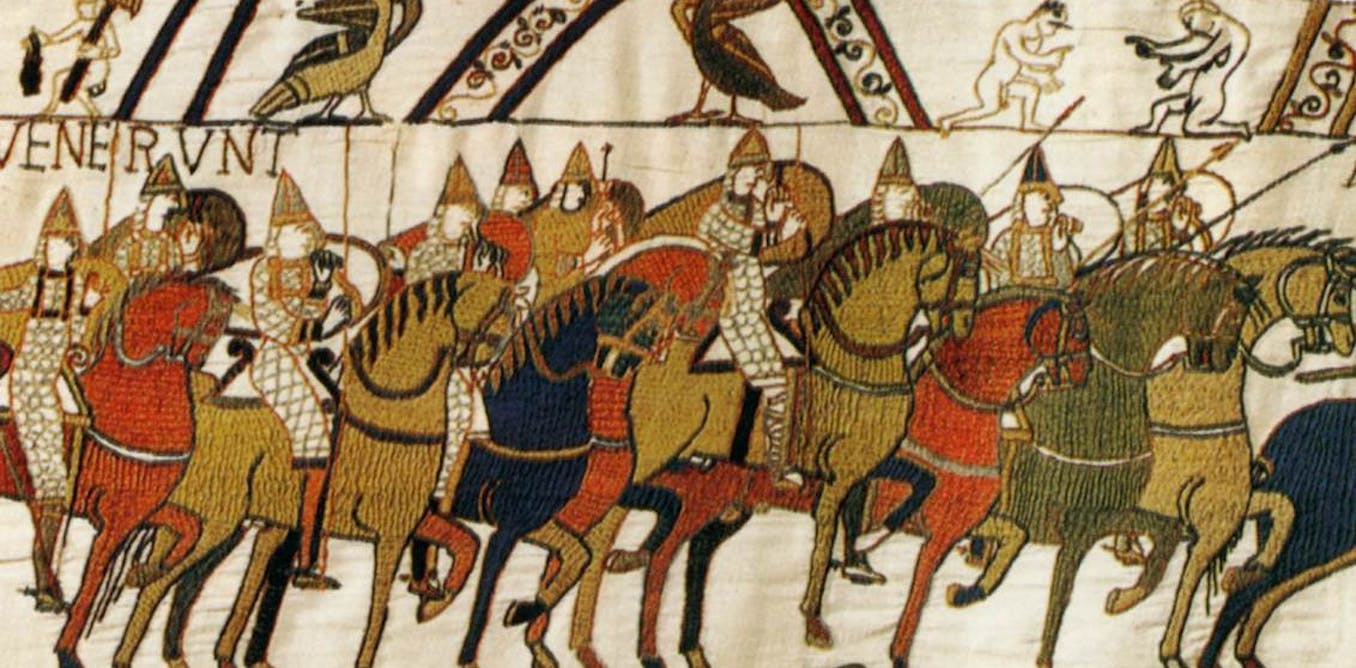
Overnight in Saint-Pierre-la-Garenne
Hotel Les Canisses (on the banks of the Seine River
halfway between Bayeux and Paris)
https://www.canisses.com/en/
DAY #11, Saturday, Oct. 27th:
*Chateau Gaillard:
The name means "strong castle" and is a ruined medieval castle,
overlooking the River Seine in Normandy. Construction began in 1196
under the auspices of Richard the Lionheart, who was simultaneously
king of England and feudal Duke of Normandy. The castle was
expensive to build but the majority of the work was done in a
short period of time - just 2 years. It is composed of a complex and
advanced design and uses early principles of concentric fortification;
the castle consists of 3 enclosures separated by dry moats, with a
keep in the inner enclosure.
residence of the exiled David II of Scotland. It changed hands
several times in the hundred years war, but in 1449 the French
king captured the Chateau from the English king definitively
and from then on it remained in French ownership. Henry IV
of France ordered the demolition of Chateau Gaillard in 1599;
although it was in ruins at the time, it was felt to be a
threat to the security of the local population.

Versailles Palace

*Basilica of St. Denis (if time permits):
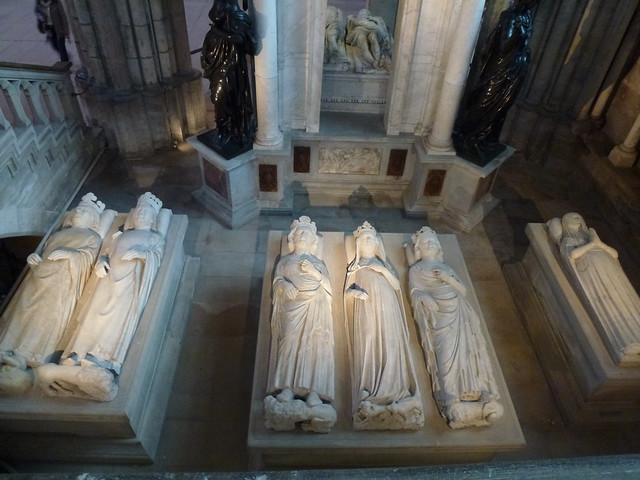
Thursday, Oct. 17th

Arrive in Paris, leave bags at Hotel and be ready to
tour by 10 am?
*Place de la Concorde:

The city's largest public square has a lengthy history as well. During the French Revolution in 1789, the statue of Louis XV of France was torn down
and the area renamed the Place de la Revolution. The new revolutionary government erected a guillotine in the square and it was here that King Louis XVI was executed on 21 January 1793,. Other important figures guillotined on the site, often in front of cheering crowds, were Marie Antoinette, Madame du Barry, Robespierre a leader in the revolution! In 1795 under the Directory, the square was renamed Place de la Concorde as a gesture of reconciliation.
The center of the Place is occupied by a giant Egyptian obelisk decorated with hieroglyphics exalting the reign of the pharaoh Ramesses II. It is one of two the Egyptian government gave to the French in the 19th century. The other one stayed in Egypt, too difficult and heavy to move to France with the technology at that time. In the 1990's President Mitterrand gave the 2nd obelisk back to the Egyptians. The 3300-year-old obelisk once marked the entrance to the Luxor Temple. in Egypt.
*Stroll up the Champs Elysees to the Arch de Triumphe:

The most famous street in Paris, this wide, tree-lined avenue is home to the city's chic restaurants, shops and boutiques and is one of the 12 grand avenues that radiate from the Arc de Triomphe. A stroll of about a mile from the Place de la Concorde, takes you to the top of the avenue crowned with the Arc itself. One of the world's best-known commemorative monuments, it stands at the center of the Place Charles de Gaulle. Napolean I commissioned the triumphal arch in 1806, after his great victory at the Battle of Austerlitz, to celebrate the military achievements of the French armies. The arch, designed by Jean Chalgrin, is 164 feet high and 148 feet wide. It sits in a circular plaza from which the 12 avenues radiate, forming a star.
Construction of the arch began in 1806 on Napoleon's birthday. Little more than the foundation had been completed by the time of his marriage to Marie-Louise in 1810 so in honor of her ceremonial entry into Paris, a full-scale depiction of the completed design, created from wood and painted canvas, was erected at the site. The actual structure was not completed until after Napoleon's abdication when work was finally resumed by King Louis XVIII and finished in 18 36.
The bodies of French famous sons including that of Victor Hugo, laid in state under the arch and leaders of conquering armies, notably Hitler, drove through the arch in a victory celebration as a Nazi flag flew from the top during the occupation of WWII.
*Tracadero Square:
This is why you came to Paris, isn't it - to see the Eiffel Tower and this is the best spot from which to take a picture of the Tower - you may very well recognize the perspective from various movies you've seen. The Trocadéro, site of the Palais de Chaillot, sits across the Seine from the Eiffel Tower. It is also the name of the 1878 palace which was demolished in 1937 to make way for the Palais de Chaillo.[1] The hill of the Trocadéro is the hill of Chaillot, a former village. The large plaza at Place de Trocadéro is a popular tourist destination to take pictures of the Eiffel Tower.
*Musee d'Orsay:

This beautiful museum, once a railroad station, now houses a
staggering collection of impressionist art including Van Gogh's
"Starry Night", some Rodin sculptures and works by Degas,
Manet, Monet, Renoir, Seurat among many others.
Built in only two years for the 1900 Universelle Expo, it was
only a train station until 1939. During WWII it was the postal
depot for POWs. The western facade, where the museum's
current entrance is, was a hotel for a long time. During each of
these incarnations, the building was frequently at risk of being
destroyed with many a valiant preservationist fighting
developers tooth and nail. Finally in 1986 Mitterand bought it
in order to showcase the art, chronologically, where the Louvre
lets off in the middle-19th century. In order to hold to our credo
- an hour in a museum is long enough to see the top sites
without sacrificing your legs and your energy for the rest of the
day - we will focus on the top sites!
*Eiffel Tower & Boat Cruise on the Seine River:
The Eiffel Tower is a wrought iron lattice tower on the Champ de
& built it. Constructed from 887-89 as the entrance to the 1889
World's Fair. It was initially criticized by some of France's leading
artists and intellectuals for its design, but it has become a global
cultural icon of France and one of the most recognizable structures
in the world and is the most-visited paid monument: 7 million
people ascended it in 2015. (Thus the terribly long lines to get in!)
The tower is 1,063 ft. tall, about the same height as an 81-storey
building and the tallest structure in Paris. During its construction, it
surpassed the Washington Monument to become the tallest man-
made structure in the world, a title it held for 41 years until the
Chrysler Building was finished in 1930. The addition of a broad-
casting aerial at the top in 1957, now makes it taller than the
Chrysler building.
(For those that don't want to wait in line to go up in the Eiffel
Tower - or "been there, done that" - we will go on the Seine River
Cruise. So you have a choice to make! Once you see the lines for
the tower, your choice may be made.)
*Seine River Cruise:

An hour-long cruise on the Seine River is a unique way to discover the city. As you pass under the famous bridges of Paris, to a narrated tour, you are able to glimpse the landmark monuments and building of the city from a unique perspective. The view of Notre Dame, which sits on an island in the middle of the river, Isle de France, will be different than in years past, due to the fire, but it has always offered a spectacular view from the river.
*Dinner together on the Champs Elysees or near
Notre Dame
DAY #2 - MORE PARIS - The City that
Never Sleeps (but we hope you do!)
*Fontainebleau Palace:

The Palace of Fontainebleau is one of the largest French royal
chateaux. The medieval castle and subsequent palace served as a
residence for the French monarchs from Louis VII to Napolean III.
Francis I and Napolean were the monarchs who had the most
influence on the palace as it stands today.
The earliest record of a fortified castle at this spot dates to 1138
and became a favorite residence and hunting lodge of the kings of
France because of the abundant game and many springs in the
surrounding forest. The palace took its name from one of the
springs, the Fountain de Bilaud.
Notable residents include Louis the 16th and Marie Antoinette
who made their last stay there in 1786 on the eve of the French
Revolution and Napoleon who made extensive renovations, to
accommodate his large ego (my opinion) renovating one room to
be his throne room.
In my opinion, Fontainebleau is as grand as Versailles, on a
slightly smaller scale, has a more interesting history, is not as
crowded and provides a much more pleasant visit than does
Versailles. If I had to choose only one to visit it would be
Fontainebleau, though the gardens are not as vast as those at
Versailles.
Napolean's Throne Room:
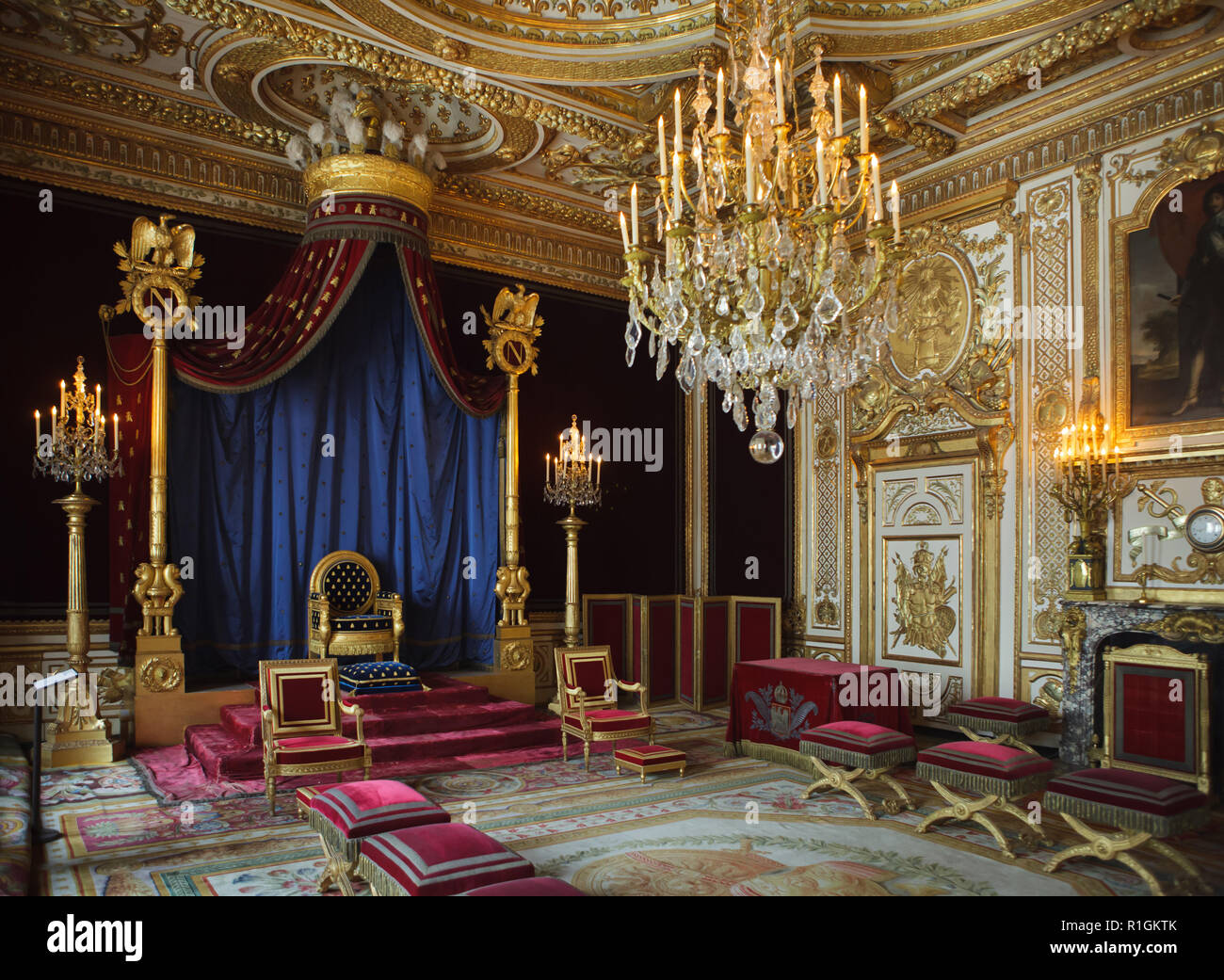
chateaux. The medieval castle and subsequent palace served as a
residence for the French monarchs from Louis VII to Napolean III.
Francis I and Napolean were the monarchs who had the most
influence on the palace as it stands today.
The earliest record of a fortified castle at this spot dates to 1138
and became a favorite residence and hunting lodge of the kings of
France because of the abundant game and many springs in the
surrounding forest. The palace took its name from one of the
springs, the Fountain de Bilaud.
Notable residents include Louis the 16th and Marie Antoinette
who made their last stay there in 1786 on the eve of the French
Revolution and Napoleon who made extensive renovations, to
accommodate his large ego (my opinion) renovating one room to
be his throne room.
In my opinion, Fontainebleau is as grand as Versailles, on a
slightly smaller scale, has a more interesting history, is not as
crowded and provides a much more pleasant visit than does
Versailles. If I had to choose only one to visit it would be
Fontainebleau, though the gardens are not as vast as those at
Versailles.
Napolean's Throne Room:

*Pere - Lachaise:

(From Trip-Savy) "One doesn't usually associate a cemetery
with a romantic stroll but a visit to Père-Lachaise begs exactly
that. Tucked away in a corner of northeastern Paris known to
locals as Menilmontant, the cemetery is affectionately called l
la cite des morts - the city of the dead - by Parisians.
With its rolling, gentle hills, thousands of trees in dozens of
varieties, winding paths with carefully plotted, elaborately
named avenues, and elaborate sepulchers and tombs, it's easy
to see why Père-Lachaise is considered Paris' most hauntingly
beautiful place of rest. If that weren't a convincing enough
reason to go for a stroll there, great figures have their resting
place here, including Chopin, Proust, Colette, and Jim
Morrison. No wonder, then, that a cemetery makes our list of
the top 10 Paris sights and attractions."
with a romantic stroll but a visit to Père-Lachaise begs exactly
that. Tucked away in a corner of northeastern Paris known to
locals as Menilmontant, the cemetery is affectionately called l
la cite des morts - the city of the dead - by Parisians.
With its rolling, gentle hills, thousands of trees in dozens of
varieties, winding paths with carefully plotted, elaborately
named avenues, and elaborate sepulchers and tombs, it's easy
to see why Père-Lachaise is considered Paris' most hauntingly
beautiful place of rest. If that weren't a convincing enough
reason to go for a stroll there, great figures have their resting
place here, including Chopin, Proust, Colette, and Jim
Morrison. No wonder, then, that a cemetery makes our list of
the top 10 Paris sights and attractions."
*Notre Dame Cathedral:

For those of us who have spent hours in Notre Dame sitting in the pews listening to choir music, & concerts, standing over the heating vents during cold winter visits, looking at the iconic rose window, examining the flying buttresses to understand how these made the height of the Gothic cathedral style possible, sitting out in the courtyard on pleasant Paris evenings, playing with the pigeons, we were devastated to watch as the very heart of Paris suffered the devastating blow of the fire on April 15th of this past year. Gone is much of the original handiwork of the Gothic builders but we are relieved that is was not a total destruction, that the two front towers survived and that enough money and interest was generated to ensure that the cathedral will rise again from the ashes. Few historic church masterpieces throughout the centuries have not suffered fires - it seems to be a given that at some point a church of that age has burned - but we had mistakenly thought that the technologies of our day would have made that possibility obsolete.
We are sorry that you won't be able to see it as it was but if you've seen it before, rely on your memories and take interest in the efforts that are being made to have it restored in 5 years time. Due to the fire, visiting hours of course have been impacted and whether tourists are allowed in at all, we don't know. Still doing some research on that. At least you will get a good view from the Seine boat cruise and as we walk around the Isle de France where it is situated.
Arguably the most stunning gothic cathedral in the world, Paris' Notre Dame Cathedral is undoubtedly the most famous. Conceived in the 12th century and comleted in the 14th, the now-iconic cathedral was the very heartbeat of medieval Paris. After a period of neglct, it recaptured the popular imagineation when Victor Hugo immortalized it in "The Hunchbakc of Notre Dame".
Notre Dame Interior - Before & After 



This is our very favorite - floor to ceiling stained glass
windows of incredible, detailed beauty - especially on a sunny day!
Sainte Chapelle, located just around the corner from Notre Dame
on the Isle de Cite was built in seven years and completed in 1248,
as part of the Palace complex of French kings until the 14th century.
It's original function was to house precious Christian relics,
including Christ's crown of thorns, acquired by Saint Louis.
Having these sacred relics in his possession made the already
powerful monarch head of western Christianity.
Stunning stained glass is featured in this church which is
considered among the highest achievements of the Rayonnant
period of Gothic architecture. The glass is arranged across 15
windows, each 15 meters high, the stained glass panels depict
1,113 scenes from the Old and New Testaments recounting the
history of the world until the arrival of the relics in Paris.
*Louvre Museum:

You've been waiting for this one, right! Thanks to the late
hours on Friday, you will have plenty of time to explore some of
the most famous pieces of art in the world housed inside the
Louvre Museum. We'll lead you around to the highlights or
you can explore with a map at your leisure!
Originally a fortress built in the 1100's, the Louvre became a
palatial residence under Louis the 1st and remained so until Louis
the 14th moved the royal residence to Versailles. It was to the
Tuileries Palace, adjacent to the Louvre, that Louis the 16th and
Marie Antoinette were sent after being arrested during the French
revolution.
In the intervening years, the museum was used for various
art academies and later under Napoleon was restored and
renovated to serve as a museum in his efforts to collect and display
art pieces from around the world, captured in his military
campaigns, through private donations and commissions. Aptly
named, "Musee Napoleon", Napoleon is credited with creating the
foundation for the museum as it is today - the largest in the world -
with a space of over 800,000 square feet and over 38,000
collection pieces. If we see 10 of them we will be doing well!
Museum Highlights Include:


Winged Victory Mona Lisa

Venus de Milo

Michaelangelo's Slave
Overnight in Paris
DAY #3 - Alsace Region, Saturday, Oct. 19th
Depart Paris via Train (TGV) - early
Arrive in Strasbourg: Visit City Highlights
*Notre Dame Cathedral:

*Strasbourg Cathedral (Notre Dame):…also known as Strasbourg Minster, is a Roman Catholic cathedral. Although considerable parts of it are still in earlier Romanesque architecture, it is widely considered to be among the finest examples of high, or late, Gothic architecture. Erwin von Steinbach is credited for major contributions from 1277 to his death in 1318.
At 466 feet, it was the world’s
tallest building from 1647 to 1874 (227 years) when it was surpassed by St.
Nikolai’s Church in Hamburg. Today it is
the 6th tallest church in the world and the highest extant structure
built entirely in the Middle Ages.
Described by Victor Hugo as a “gigantic
and delicate marvel” and by Goethe as a “sublimely towering, wide-spreading
tree of God”, the cathedral is visible far across the plains of Alsace and can
be seen from as far off as the Vosges Mountains of the Black Forest on theother
side of the Rhine, Sandstone from the Vosges used in construction gives the
cathedral its characteristic pink hue.

La Petite France:
…is
an historic quarter of the city of Strasbourg.
It is located at the western end of the Grande Ile (river), which contains the historical center of the
city. At Petite France, the River Ill
splits up into a number of channels that cascade through an area that, was in
the Middle Ages, home to the city’s tanners, millers and fishermen and is now one
of Strasbourg’s main tourist attractions.
Just
up-stream of Petite France, the river
flows through the Barrage Vauban, a
defensive structure built at the end of the 17h century. Downstream of this, the river splits into the
Canal du Faux-Rempart, which flows to
the north of the Grand Ile, and forms
channels which flow through the Petite
France quarter before reuniting in the main channel of the river, flowing
to the south of the Grande Ile.
Downstream
of the Ponts Couverts, the four
channels flow through an area of largely half-timbered buildings which,
together with the narrow lanes and footbridges that connect them mostly date
from the 16th and 17th centuries. The sloping roofs of many of the buildings
include open lofts where hides were once dried.
On the north bank of the Ill at the heart of the quarter is the Maison des Tanneurs, home of the Tanner’s
Guild.
*Maison Du Fromage: (The Cheese House)
The House of
Cheese - In the village of Munster in Alsace will allow us to discover the manufacturing of and taste the local famous Munster cheese.
*Le Hohneck: (if daylight allows)
Third highest summit
of the Vosges Mountains, the Hohneck is an
amazing mountain from where you can take a lot of different trails (like
the Sentier des Roches, a must-do in the area). Great
views for little effort if you park at the top! Even letting the car do most of
the hard work, an easy walk around the summit area and down to a couple of the
nearby cols give you views to the valleys in the east which are amazing.

Dinner & Overnight in Colmar:
Hotel Turenne: http://www.turenne.com/en/

Day #4 - Sunday, Oct. 20th No Sass, Alsace!
*Church at Branch at Colmar:
*Visit Riquewihr:
Will these darling villages never end! This is one of our favorites, where we

*Explore Colmar (and a late lunch)
Dazzling colors, canals, the wonder of half-timbered buildings
that look like a perfect illustration—these are the things of
Colmar, France. Its streets twist and meander into tiny alleys
and then open into small squares used by traders and merchants
centuries ago. Its mostly pedestrian center is a festival of
brightly tiled roofs and even brighter facades, welcoming the
curious.
Will these darling villages never end! This is one of our favorites, where we
spent the perfect Christmas with family several years ago - including staying in one
of these timbered buildings, walking out to the square on Christmas Eve to hear
a choir singing Silent Night in French and German, eating Munster cheese with
potatoes cooked in a large open kettle and munching on crepes and bretzels,
which are sure to be a favorite - a fat, soft pretzel with melted Munster cheese and
bacon on top. The Katie Wohlfarht store is an enchanting shop where you can
buy wooden Christmas ornaments, smokers and nutcrackers (though you'll see
another of these shops in Heidelberg.)
Riquewihr, dating to 1291, looks today more or less as it did in the 16th century.
It is officially one of the most beautiful villages in France, or Les plus beaux
villages de France. It is one of the few towns in the area not to be badly damaged
during WW II and is still surrounded by its medieval fortifications and is
overlooked by a castle from the same period which is today, a museum.
overlooked by a castle from the same period which is today, a museum.

Dazzling colors, canals, the wonder of half-timbered buildings
that look like a perfect illustration—these are the things of
Colmar, France. Its streets twist and meander into tiny alleys
and then open into small squares used by traders and merchants
centuries ago. Its mostly pedestrian center is a festival of
brightly tiled roofs and even brighter facades, welcoming the
curious.
This corner of France,
known as Alsace, has changed hands
several times with Germany over the centuries. As a result,
Colmar and nearby small French towns have a distinctive
culture all their own influenced by those who have claimed the
region. From language to food to architecture, everything is a
little French and a little German. Remarkably, Colmar’s historic
beauty was preserved during World War II, so its tiled roofs,
cobbled lanes, and centuries’ old buildings are around for us to
marvel at today.
several times with Germany over the centuries. As a result,
Colmar and nearby small French towns have a distinctive
culture all their own influenced by those who have claimed the
region. From language to food to architecture, everything is a
little French and a little German. Remarkably, Colmar’s historic
beauty was preserved during World War II, so its tiled roofs,
cobbled lanes, and centuries’ old buildings are around for us to
marvel at today.
PETITE VENICE:
No matter
how much time you have, Petite Venise
(Little Venice) is an absolute Colmar must see. This
stretch of lovely half-timbered buildings along the canal is
(Little Venice) is an absolute Colmar must see. This
stretch of lovely half-timbered buildings along the canal is
certainly the most picturesque view in Colmar. Walking
along here, it’s hard not to feel like you’ve stepped into the
middle of a fairytale or a scene from Disney. But there’s
nothing Disneyfied about it—the sherbet-colored rustic
homes and businesses along the water have been this way
for 400years or more, although they’re probably a little
brighter now.
along here, it’s hard not to feel like you’ve stepped into the
middle of a fairytale or a scene from Disney. But there’s
nothing Disneyfied about it—the sherbet-colored rustic
homes and businesses along the water have been this way
for 400years or more, although they’re probably a little
brighter now.
In
the Middle Ages, the river Lauch was redirected to
the center of Colmar to supply water to the town for
drinking and business. The surrounding area—as the
street names indicate- was home to the butchers,
tanners, and fishmongers, and the water helped power
the businesses and move goods around.
Even the market hall has steps going down to the water
to receive items being transported.

the center of Colmar to supply water to the town for
drinking and business. The surrounding area—as the
street names indicate- was home to the butchers,
tanners, and fishmongers, and the water helped power
the businesses and move goods around.
Even the market hall has steps going down to the water
to receive items being transported.

MUSEE UNTERLINDEN:
The museum, housed in a 13th century Dominican convent,
is home to the Isenheim Altarpiece by Matthis Grenwald and
features a large collection oflocal and international artworks
and artifacts from prehistori to contemporary times. The
museum bears the quality label Musee de France and is one
of the most visited outside of Paris.

Overnight
at Colmar: Hotel Turenne
DAY #5 - Across the Western Front:
Monday, Oct. 21st
Drive to Heidelberg, Germany
Heidelberg is often called one of the most romantic towns in
Germany. It's colorful alleyways, vibrant university population
and prime location on the river all contribute to its charm.
 *Visit Heidelberg Castle:
*Visit Heidelberg Castle:
Heidelberg Castle is built of red Neckar Sandstone on the
terraced hillside above the city. This 16 century castle is one
of the best examples of German Renaissance architecture.
After its destruction by the French, who devastated the
Palatinate in the 17th century, it has remained the largest
and most picturesque such ruin in Germany.
On the grounds of the castle, the German Museum of
Pharmacy covers the history of apothecaries during the 18th
and 19th centuries. Displays include fascinating old instru-
ments and tools of the trade, as well as examples of the
preparations used by these early pharmacists. Furnishings
from pharmacies since the Baroque periods and medical
books are also featured and even our grandchildren found
it interesting!
If we feel like more walking and marvelous views we can
take the cable car (funicular railway) that we will ride to the
castle to the Konigstuhl (King's seat) which is a hill rising
1600 feet high with spectacular views as far as the Rhine
Valley. It's an excellent place to explore the beautiful
countryside surrounding Heidelberg. Some of us may just
sit back at a gasthaus and enjoy hot chocolate!

*Explore Heidelberg Altstadt (Old town) & Lunch

WALK THE RIVER NECKAR & ALTE BRUCKE:
Strolling along the river is a pleasant way to see some of the city's side
streets and small alleyways which are very interesting to explore. The old
bridge is worth a walk to see the striped medieval gate and wonderful views
of the castle.


DAY #6 - Is it France or is it Germany?
Back to Alsace - Tuesday, Oct. 22nd

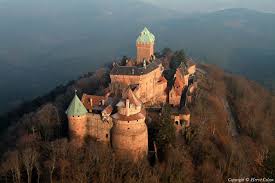

The Lace Cathedral
Overnight in Rouen

DAY #5 - Across the Western Front:
Monday, Oct. 21st
Drive to Heidelberg, Germany
Heidelberg is often called one of the most romantic towns in
Germany. It's colorful alleyways, vibrant university population
and prime location on the river all contribute to its charm.

Heidelberg Castle is built of red Neckar Sandstone on the
terraced hillside above the city. This 16 century castle is one
of the best examples of German Renaissance architecture.
After its destruction by the French, who devastated the
Palatinate in the 17th century, it has remained the largest
and most picturesque such ruin in Germany.
On the grounds of the castle, the German Museum of
Pharmacy covers the history of apothecaries during the 18th
and 19th centuries. Displays include fascinating old instru-
ments and tools of the trade, as well as examples of the
preparations used by these early pharmacists. Furnishings
from pharmacies since the Baroque periods and medical
books are also featured and even our grandchildren found
it interesting!
If we feel like more walking and marvelous views we can
take the cable car (funicular railway) that we will ride to the
castle to the Konigstuhl (King's seat) which is a hill rising
1600 feet high with spectacular views as far as the Rhine
Valley. It's an excellent place to explore the beautiful
countryside surrounding Heidelberg. Some of us may just
sit back at a gasthaus and enjoy hot chocolate!

*Explore Heidelberg Altstadt (Old town) & Lunch
The Hauptstrasse,
or main street is the world’s longest continuous
Pedestrian shopping street where we can
explore tons of shops and find a
Gasthaus (guesthouse) to eat genuine hearty German food. If you hear
them pounding out our schnitzel with a
mallet, you know the meat is fresh.
Our recommendations: yaegerschnitzel with spaetzle (hunter’s schnitzel
with mushrooms in a rich gravy and
delicate noodles) cordon bleu – pork
schnitzel stuffed with ham and swiss, goulasch suppe – to recommend a
few and plenty of brats of various sizes and colors with sauerkraut for the
Brat lovers among you.) Rich will be sure we remember dessert: Apple
Strudel!
We’ll take a look at the Rathaus
(city hall) – some of the town’s mayors
must have been rats! Ad the Marktplatz (market place) to see the
Hercules Fountain where petty criminals were chained during medieval times.

WALK THE RIVER NECKAR & ALTE BRUCKE:
Strolling along the river is a pleasant way to see some of the city's side
streets and small alleyways which are very interesting to explore. The old
bridge is worth a walk to see the striped medieval gate and wonderful views
of the castle.

Overnight in Heidelberg:
Hotel Zum Ritter, St. Georg:
(What an amazing building - recommended to visit as a tourist
for the architecture of this Renaissance building, built in 1592 and recommended as a top place to stay by Rick Steves - and we
get to sleep here!) http://www.hotel-ritter-heidelberg.com

DAY #6 - Is it France or is it Germany?
Back to Alsace - Tuesday, Oct. 22nd
*Musee Memorial Le Linge: (WWI trenches)
Le Linge is a battlefield where a deadly
confrontation
took place between 20 July-October 1918, during WWI.
Designated a historic site in 1921 it was one of the
deadliest battlefields of the war. During the conflict, the
Germans had organized their defenses along the crestline
of Le Linge ridge to keep the French troops from
advancing toward Colmar. The Chasseurs Alpins, many
between the ages of 19 and 20 launched an assault against
this impregnable bastion. Gas shells and flamethrowers
were used. Some 10,000 Frenchmen and 7,000 Germans
died during this period before the troops reached
took place between 20 July-October 1918, during WWI.
Designated a historic site in 1921 it was one of the
deadliest battlefields of the war. During the conflict, the
Germans had organized their defenses along the crestline
of Le Linge ridge to keep the French troops from
advancing toward Colmar. The Chasseurs Alpins, many
between the ages of 19 and 20 launched an assault against
this impregnable bastion. Gas shells and flamethrowers
were used. Some 10,000 Frenchmen and 7,000 Germans
died during this period before the troops reached
a standoff.
Visitors have called it an unexpected and very moving
experience with an informative museum as well as the
opportunity to walk through the trenches where the
battles were fought.
experience with an informative museum as well as the
opportunity to walk through the trenches where the
battles were fought.

*Chateau Du Haut-Koenigsbourg:
…is
a medieval castle near Colmar in Alsace, located in
the Vosges mountains and situated in a strategic area on
a rocky spur overlooking the Upper Rhine Plains. It is
not known when the first castle was built however it is
documented in1147 when the monks complained to King
Louis VII of France about its unlawful construction by
Duke Frederick II of Swabia. Frederick’s younger
brother Conrad III had been elected King of the
Romans in 1138 and by 1192 the castle was called by its
the Vosges mountains and situated in a strategic area on
a rocky spur overlooking the Upper Rhine Plains. It is
not known when the first castle was built however it is
documented in1147 when the monks complained to King
Louis VII of France about its unlawful construction by
Duke Frederick II of Swabia. Frederick’s younger
brother Conrad III had been elected King of the
Romans in 1138 and by 1192 the castle was called by its
current name – “King’s
Castle”.
It was used by successive powers from the Middle
Ages until the Thirty Years War when is was abandoned.
From 1900 – 1908 it was rebuilt at the behest of the
German Kaiser Wilhelm II. Today it attracts more than
a half million visitors per year.
Ages until the Thirty Years War when is was abandoned.
From 1900 – 1908 it was rebuilt at the behest of the
German Kaiser Wilhelm II. Today it attracts more than
a half million visitors per year.
*Cooking Class & Dinner:
We will learn to cook a French Bistro dinner with an
instructor at a French cooking school. Our menu will
consist of Menu bistrot: Pavé de boeuf en croûte d'échalote,
châtaignes et rösti de pommes de terre Clafoutis aux
mangues épicées or in other words: Beef steak in shallot
crust, chestnuts and rösti of potatoes Clafoutis with
spicy mangoes (clafoutis is a pastry similar to a custard
pie with fruit.) What fun cooking and then dining on
authentic French cuisine! (This is one of the included
dinners on the tour.)
Overnight in Obernai: Le Colombier Hotel
https://www.hotel-colombier.com/fr/
We will learn to cook a French Bistro dinner with an
instructor at a French cooking school. Our menu will
consist of Menu bistrot: Pavé de boeuf en croûte d'échalote,
châtaignes et rösti de pommes de terre Clafoutis aux
mangues épicées or in other words: Beef steak in shallot
crust, chestnuts and rösti of potatoes Clafoutis with
spicy mangoes (clafoutis is a pastry similar to a custard
pie with fruit.) What fun cooking and then dining on
authentic French cuisine! (This is one of the included
dinners on the tour.)
Overnight in Obernai: Le Colombier Hotel
https://www.hotel-colombier.com/fr/
DAY #7 - Wednesday, Oct 23rd,
Norman Haunts!
Norman Haunts!
Early Departure from Strasbourg via rented vans to
Rouen, Normandy.
*Stop at Reims for lunch and a peak at the Cathedral

Rouen:
*Rouen Sites:
Rouen, Normandy.
*Stop at Reims for lunch and a peak at the Cathedral
Another Notre Dame? Every big town has to have one! What's your favorite and how to do you tell them apart? Well, this one, the Reims Cathedral is a very old one, the first church on its site built in 401 on the site of a Gallo-Roman bath. Dedicated to the Virgin Mary as all Notre Dames are, it is famous for being the traditional location for the coronations of the kings of France.
Construction of the current cathedral began in the 13th century and concluded in the 15th, built to replace an earlier church, destroyed by fire in 1221.
During the 100 Years War, the cathedral and city were under siege by the English in 1359 but the siege failed and in 1380 the cathedral was the location of Charles VIs coronation and eight years later Charles called a council at Reims in 1388 to take personal rule from the control of his uncles. After Henry the V of England defeated Charles' army at Agincourt, Reims along with most of northern France fell to the English. The English held Reims until 1429 when it was liberated by Joan of Arc, which allowed the Dauphin Charles to be crowned king on 17 July 1429. Following the death of Francis I of France, Henry II was crowned king of France in the cathedral in July of 1547.
Although Reims was an important symbol of the French monarchy, the chaos of the French Revolution did not damage it to the same extent as at Chartres where the structure of the cathedral itself was threatened. Some statutes were broken,the gates were torn down and the royal Hand of Justice was burned.
*Rouen Sites:
Rouen is known for its Rouen Cathedral, with its Tour de Beurre (butter tower) financed by the sale of indulgences for the consumption of butter during Lent. The cathedral's gothic façade (completed in the 16th century) was the subject of a series of paintings by Claude Monet, some of which are exhibited in the Musée d'Orsay in Paris.
The Gros Horloge is an astronomical clock dating back to the 14th century.[1] It is located in the Gros Horloge street.
Other famous structures include Rouen Castle, whose keep is known as the tour Jeanne d'Arc, where Joan of Arc was brought in 1431 to be threatened with torture (contrary to popular belief, she was not imprisoned there but in the since destroyed tour de lady Pucelle); the Church of Saint Ouen (12th–15th century); the Palais de Justice, which was once the seat of the Parlement (French court of law) of Normandy; the Gothic Church of St Maclou (15th century); and the Museum of Fine Arts and Ceramics which contains a splendid collection of faïence and porcelain for which Rouen was renowned during the 16th to 18th centuries. Rouen is also noted for its surviving half-timbered buildings.

The Lace Cathedral
Overnight in Rouen
Hotels Les Inites & Le Vieux Carre:
Les Inites: https://les-inities-hotel-rouen.booked.net/
Day #8: Thursday, Oct. 24th
"Can't "resist" Brittany"
(specifically, the food)
*Rocheforte-en-Terre:
Les Inites: https://les-inities-hotel-rouen.booked.net/
Day #8: Thursday, Oct. 24th
"Can't "resist" Brittany"
(specifically, the food)
Early departure for Dinan, Brittany
*Market Day in Dinan: 

"In France, if you have time for only one stop
in Brittany, make it the ancient riverfront city of
Dinan. Dinan's hefty ramparts bundle its half-
timbered and cobbled quaintness into Brittany's
best medieval town center. While it has a
touristic icing — plenty of crêperies, shops
peddling Brittany kitsch and colorful flags — it is
also clearly a work-a-day town filled with locals
who take pride in their Breton culture. Music stores,
for instance, sell more Celtic music than anything
else.
in Brittany, make it the ancient riverfront city of
Dinan. Dinan's hefty ramparts bundle its half-
timbered and cobbled quaintness into Brittany's
best medieval town center. While it has a
touristic icing — plenty of crêperies, shops
peddling Brittany kitsch and colorful flags — it is
also clearly a work-a-day town filled with locals
who take pride in their Breton culture. Music stores,
for instance, sell more Celtic music than anything
else.
Dinan isn't about museums, castles or other
must-sees. Frankly, I wouldn't go through a turnstile
here. The attraction is the town itself, delightfully
preserved because it escaped the bombs of World
War II. Enjoy the old town center, scramble the
ramparts and relax at the riverfront harbor. The
sprawling town square, Place du Guesclin, is named
after a 14th-century military leader famous for
victories over England. For 700 years, merchants
have filled the square to sell their produce and
crafts — these days, vendors are out in force on
Thursday mornings." (By Rick Steves)
must-sees. Frankly, I wouldn't go through a turnstile
here. The attraction is the town itself, delightfully
preserved because it escaped the bombs of World
War II. Enjoy the old town center, scramble the
ramparts and relax at the riverfront harbor. The
sprawling town square, Place du Guesclin, is named
after a 14th-century military leader famous for
victories over England. For 700 years, merchants
have filled the square to sell their produce and
crafts — these days, vendors are out in force on
Thursday mornings." (By Rick Steves)
*Rocheforte-en-Terre:
Built on a promontory,Rochefort-en-Terre occupies
a magnificent site. Awarded "Most beautiful
Village of France" for its half-timbered houses of wood,
its buildings of Gothic Renaissance and its castle
mansions. The stone is ubiquitous, it is the link between
these different testimonies of history despite the
diversity of the architectural currents that are expressed.
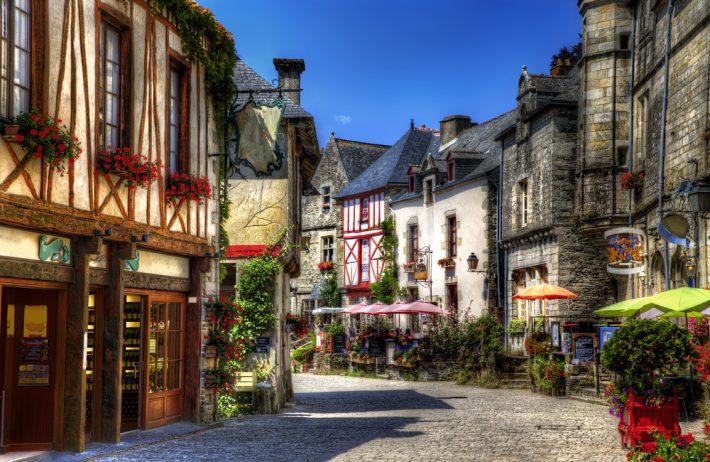
a magnificent site. Awarded "Most beautiful
Village of France" for its half-timbered houses of wood,
its buildings of Gothic Renaissance and its castle
mansions. The stone is ubiquitous, it is the link between
these different testimonies of history despite the
diversity of the architectural currents that are expressed.

Rennes: & Cathedral:
Rennes is the capital of the region of Brittany, whose
history goes back more than 2,000 years, at a time when
it was a small Gallic village name Condate. Together with
Vannes and Nantes, it is one of the major cities of the
ancient Duchy of Brittany.
history goes back more than 2,000 years, at a time when
it was a small Gallic village name Condate. Together with
Vannes and Nantes, it is one of the major cities of the
ancient Duchy of Brittany.
In 2015, the city was the 10th largest in Frances, with a
metropolitan area of about 720,000 inhabitants. With
more than 66,000 students in 2016, it is also the 8th
largest University campus of France. In 2018, it was
named as “the most liveable city in France.”
more than 66,000 students in 2016, it is also the 8th
largest University campus of France. In 2018, it was
named as “the most liveable city in France.”
Hotel Alvor:
"A hotel in the heart of the medieval city of Dinan, this hotel is
an elegant residence dating back to the 18th century, in a
Renaissance-style building, where all the stops are pulled out
to ensure that your stay in Brittany is an unforgettable one.
On the former site of a Jacobin convent, the hotel has an
enchanting authentic atmosphere."
"A hotel in the heart of the medieval city of Dinan, this hotel is
an elegant residence dating back to the 18th century, in a
Renaissance-style building, where all the stops are pulled out
to ensure that your stay in Brittany is an unforgettable one.
On the former site of a Jacobin convent, the hotel has an
enchanting authentic atmosphere."
Could we find a more charming place to stay - we doubt it!

DAY #9 - Friday, Oct. 25th, Bretagne:
Couldn't resist so just a bit more Brit!
Drive About Brittany:
*St. Malo - Fishing Village of Brittany:
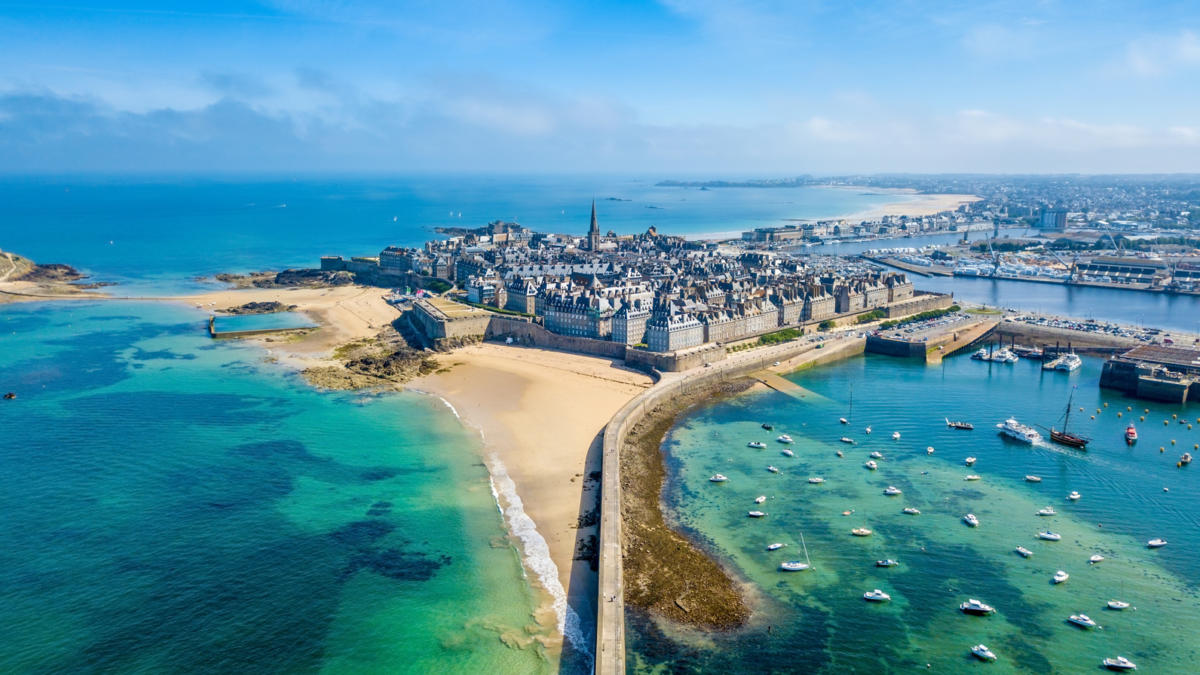
St. Malo:
St. Malo is best known as having been a breeding ground for
privateers, who based themselves in the St. Servan district.
During the 1st century AD, the Welsh monk, St. Maclou, built a
church on the site of the Roman city of Alet. The walled city has
a long history of piracy, earning much wealth from local
extortion and overseas adventures.
In 1944, the Allies heavily bombarded Saint-Malo, which was
garrisoned by German troops and the city was almost totally
destroyed . However over a period of 12 years, 1948 - 1960 the
city was rebuilt Today it is a popular tourist center, with a ferry
terminal serving the islands of Jersey and Guernsey. Walking
through the cobbled streets of this historic walled city's old
town, you feel as though you've stepped back in time and one
experiences an authentic glimpse into Brittany's important
seafaring past. One of the highlights is walking the ramparts
surrounding the city, as you look out over the English Channel
with the sea-farers winds whipping at your hair.
Ramparts of St. Malo:
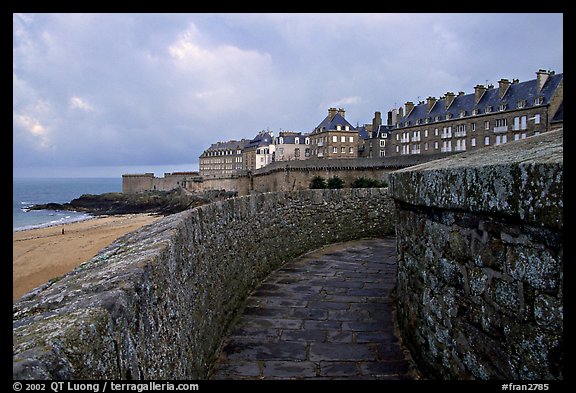
*L'Orient & Lunch in market:
*Keroman Submarine Base: (German WWII)
Keroman Base was a German U-Boat base during WWII,
built in June 1940. Between February 1941 and January 1942,
3 gigantic reinforced concrete structures were built on the
Keroman peninsula, called K1, K2, and K 3. The base was
capable of sheltering 30 submarines under cover.
After allies failed to damage the U-Boat bunkers the
bombing shifted to the city itself to deny the Germans workers
and other resources. Before these bombings, thousands of
leaflets were dropped on the population instructing the
inhabitants to evacuate.[17] Between 14 January 1943 and 17
February 1943, as many as 500 high-explosive aerial bombs
and more than 60,000 incendiary bombs were dropped.
Although Lorient was heavily damaged by allied bombing
raids, the base survived through to the end of the war.
Keroman was held until May 1945 though surrounded by the
American Army but the Germans refused to surrender. It is
now a historical site where we will take a guided tour of
the K3, which is the largest of the submarine blocks
Overnight in Dinan
DAY #10, Saturday, Oct. 26th:
NORMANDY - Beauty stitched among
sobering reflections.

St. Malo:
St. Malo is best known as having been a breeding ground for
privateers, who based themselves in the St. Servan district.
During the 1st century AD, the Welsh monk, St. Maclou, built a
church on the site of the Roman city of Alet. The walled city has
a long history of piracy, earning much wealth from local
extortion and overseas adventures.
In 1944, the Allies heavily bombarded Saint-Malo, which was
garrisoned by German troops and the city was almost totally
destroyed . However over a period of 12 years, 1948 - 1960 the
city was rebuilt Today it is a popular tourist center, with a ferry
terminal serving the islands of Jersey and Guernsey. Walking
through the cobbled streets of this historic walled city's old
town, you feel as though you've stepped back in time and one
experiences an authentic glimpse into Brittany's important
seafaring past. One of the highlights is walking the ramparts
surrounding the city, as you look out over the English Channel
with the sea-farers winds whipping at your hair.
Ramparts of St. Malo:

*L'Orient & Lunch in market:
*Keroman Submarine Base: (German WWII)
Keroman Base was a German U-Boat base during WWII,
built in June 1940. Between February 1941 and January 1942,
3 gigantic reinforced concrete structures were built on the
Keroman peninsula, called K1, K2, and K 3. The base was
capable of sheltering 30 submarines under cover.
After allies failed to damage the U-Boat bunkers the
bombing shifted to the city itself to deny the Germans workers
and other resources. Before these bombings, thousands of
leaflets were dropped on the population instructing the
inhabitants to evacuate.[17] Between 14 January 1943 and 17
February 1943, as many as 500 high-explosive aerial bombs
and more than 60,000 incendiary bombs were dropped.
Although Lorient was heavily damaged by allied bombing
raids, the base survived through to the end of the war.
Keroman was held until May 1945 though surrounded by the
American Army but the Germans refused to surrender. It is
now a historical site where we will take a guided tour of
the K3, which is the largest of the submarine blocks
Keroman Submarine Base

Overnight in Dinan
DAY #10, Saturday, Oct. 26th:
NORMANDY - Beauty stitched among
sobering reflections.
*Mont St. Michel:
...is an island at the mouth of the Couesnon River. As of 2015
it had a population of 50. The island has held strategic fortifi-
cations since ancient times and since the 700s has been the seat
of the monastery from which it draws its name. The structural
composition of the town exemplifies the feudal society that
constructed it: on top, God, the abbey and monastery: below
the great halls; then stores and houses; and at the bottom,
outside the walls, houses for fishermen and farmers.
The commune's position, on an island just a few hundred
meters from land, made it accessible at low tide to the many
pilgrims to its abbey, but defensible as an incoming tide
stranded, drove off, or drowned would-be assailants. The
mount remained unconquered during the Hundred Year's
War. Louis the XI turned the Mount into a prison. There-
after the abbey began to be used regularly as a jail before the
revolution.
One of my favorite sites to visit in France, it appears through
the water's mist like a miraged castle. The hike up the narrow
lanes are challenging, but I managed it during a ferocious bout
of morning sickness many years ago, determined not to miss
out! So glad to see it again with a calmer stomach but a slower
gait. Truly an amazing place to visit!
Mont St. Michel

Saint-Lo: Picnic Lunch
The city has long been an important center of the eco-
nomy of Nomandy. It has been coveted by neighboring
nations, including England, resulting in many successive
invasions. It lost its dominant position towards the end of
the 1800s because it failed to take advantage of the first
Industrial Revolution, which instead affected much of the
predominantly peasant population. Originally called
Briovere (meaning "Bridge on the Vire River" in Gaulish)
the town is built on and around ramparts. The town
started life as a Gallic fortified settlement, but was con-
quered by the Romans in 56 BC.
The Battle of Saint-Lo is one of the 3 conflicts in the Battle
of the Hedgerows which took place in July 1944, just before
Operation Cobra. Saint-Lo had fallen to Germany in 1940
and after the invasion of Normandy, the US targeted the city
as it served as a strategic crossroads. American bombard-
ments caused heavy damage (up to 95% of the city was
destroyed) with a high number of casualties, which resulted
the martyred city being called "The Capital of Ruins."
From this photo you can see the catastrophic damage the
city sustained in WWII. The city was not rebuilt, but the
rubble cleared away and new structures built. None of the
charming half-beamed building of cities such as Dinan
which were not bombed.
Saint-Lo WWII Destruction

D-day Sites:
*Pointe de Hoc:
...is a promontory with a 100 ft. cliff overlooking the English
channel n the northwestern coast of Normandy. During WWII
it was the highest point between Utah Beach to the west and
Omaha Beach to the east. The Germany army fortified the area
concrete casemates and gun pits. On D-Day, the U.S. Army Ranger
Assault Group captured Pointe de Hoc after scaling the cliffs.
Here we can visit the German bunkers used during the invasion.
Pointe de Hoc
*WWII U.S. Cemetery
On June 8, 1944, the US First Army established the temporary
cemetery, the 1st American cemetery on European soil in WW II.
After the war, the present-day cemetery was established a short
distance to the east of the original site. It is located on a bluff over-
looking Omaha Beach and the English Channel. France has
granted the US a special, perpetual concession to the land
occupied by the cemetery, free from any charge or tax to
honor the forces. The cemetery is managed by the
American Battle Monuments Commission, a small
independent agency of the US federal government. The US
flag flies over these granted soils.
The cemetery site, at the north end of a half mile access road
covers 172 acres and contains the graves of 9.385 of our military
dead, most of whom lost their lives in the D-Day landings and
ensuing operations. Included are graves of Army Air Corps crews
shot down over France as early as 1942 and 3 American women.
A new $30 million visitor center was dedicated in 2007. In
addition to exhibits, the center includes 3 informational visitor
films.
US WWII Cemetery, Normandy

*Omaha Beach:
five sectors of the Allied invasion of German-occupied France in
the Normandy landings on June 6, 1944, during World War II.
'Omaha' refers to a section of the coast of Normandy, France,
facing the English Channel 8 kilometers (5 mi) long, from east of
Sainte-Honorine-des-Pertes to west of Vierville-sur-Mer on the
right bank of the Douve River estuary and an estimated 150-foot
(45 m) tall cliffs. Landings here were necessary to link the British
landings to the east at Gold with the American landing to the west
at Utah, thus providing a continuous lodgement on the Normandy
coast of the Bay of the Seine. Taking Omaha was to be the respon-
sibility of United States Army troops, with sea transport, mine
sweeping, and a naval bombardment force provided predomi-
nantly by the U. S. Navy and Coast Guard, with contributions
from the British, Canadian, and Free French navies.
The primary objective at Omaha was to secure a beachhead of
eight kilometres (5.0 miles) depth, between Port-en-Bessin and the
Vire River, linking with the British landings at Gold to the east, and
reaching the area of Isigny to the west to link up with VII Corps
landing at Utah. Opposing the landings was the German 352nd
Infantry Division. Of the 12,020 men of the division, 6,800 were
experienced combat troops, detailed to defend a 53-kilometer
(33 mi) front. The German strategy was based on defeating any
seaborne assault at the water line, and the defenses were mainly
deployed in strongpoints along the coast. The untested American
29th Infantry Division, along with nine companies of U.S. Army
Rangers redirected from Pointe du Hoc, assaulted the western half
of the beach. The battle-hardened 1st Infantry Division was given the
eastern half. The initial assault waves, consisting of tanks, infantry,
and combat engineer forces, were carefully planned to reduce the
coastal defenses and allow the larger ships of the follow-up waves
to land.
Very little went as planned during the landing at Omaha. Difficul-
ties in navigation caused the majority of landing craft to miss their
targets throughout the day. the defenses were unexpectedly strong,
and inflicted heavy casualties on landing U.S. troops. Under heavy
fire, the engineers struggled to clear the beach obstacles, later
landings bunched up around the few channels that were cleared.
Weakened by the casualties taken just in landing, the surviving
assault troops could not clear the heavily defended exits off the
beach. This caused further problems and consequent delays for
later landings. Small penetrations were eventually achieved by
groups of survivors making improvised assaults, scaling the bluffs
between the most heavily defended points. By the end of the day,
two small isolated footholds had been won, which were subsequently
exploited against weaker defenses further inland, thus achieving the
original D-Day objectives over the following days.
Omaha Beach - then.... and now


*Bayeux Tapestry:
The Bayeux Tapestry (actually an embroidery) is an
embroidered cloth nearly 230 ft. long and 20 inches tall.
which depicts the events leading up to the Norman
conquest of England involving William the Duke of
Normandy (the Conqueror) and Harold, Earl of Wessex,
later King of England, and culminating in the Battle of
Hastings. It is thought to date to the 11th century, within
a few years after the battle. It tells the story from the
point of view of the conquering Normans but is now
agreed to have been made in England.
According to Sylvette Lemagnen, conservator of the
tapestry, "the tapestry is one of the supreme
achievements of the Norman Romanesque....its
survival almost intact over nine centuries is little short
of miraculous...its exceptional length, the harmony
and freshness of its colors, its exquisite workmanship,
and the genius of its guiding spirit combine to make it
endlessly fascinating."
The cloth consists of some 50 scenes with Latin,
embroidered on linen with colored woolen yarns. It is
likely that is was commissioned by Bishop Odo,
William's half-brother and made in England - not
Bayeux - in the 1070s. In 1729 it was rediscovered by
scholars at a time when it was being displayed annually
in Bayeux Cathedral.
Bayeux Tapestry

Overnight in Saint-Pierre-la-Garenne
Hotel Les Canisses (on the banks of the Seine River
halfway between Bayeux and Paris)
https://www.canisses.com/en/
DAY #11, Saturday, Oct. 27th:
*Chateau Gaillard:
The name means "strong castle" and is a ruined medieval castle,
overlooking the River Seine in Normandy. Construction began in 1196
under the auspices of Richard the Lionheart, who was simultaneously
king of England and feudal Duke of Normandy. The castle was
expensive to build but the majority of the work was done in a
short period of time - just 2 years. It is composed of a complex and
advanced design and uses early principles of concentric fortification;
the castle consists of 3 enclosures separated by dry moats, with a
keep in the inner enclosure.
The Chateau was captured in 1204 by the king of France, Phillip II,
after a lengthy siege. In the mid-14th century, the castle was the residence of the exiled David II of Scotland. It changed hands
several times in the hundred years war, but in 1449 the French
king captured the Chateau from the English king definitively
and from then on it remained in French ownership. Henry IV
of France ordered the demolition of Chateau Gaillard in 1599;
although it was in ruins at the time, it was felt to be a
threat to the security of the local population.

*Versailles Palace & Gardens:
The Palace of Versailles, 12 miles southwest of Paris is one
of the greatest achievements in French 17th century architecture.
Louis XIII’s old hunting pavilion was transformed and extended
by his son, Louis XIV, when he installed the court and
government there in 1682. A succession of kings continued
to embellish the palace up until the French Revolution.
Today the Palace contains 2,300 rooms.
The palace now a UNESCO World Heritage site, is notable
especially for the ceremonial Hall of Mirrors, the jewel-like
RoyalOpera and the royal apartments. The small rustic
Hamlet created for Marie Antoinette as well as the vast
Gardens of Versailles with fountains, canals and geometric
flower beds and groves also attract visitors. The Palace
was stripped of all its furnishings after the French
Revolution but many pieces have been returned
and many of the palace rooms have been restored.
Rich served a good part of his mission in Versailles,
(though not in the palace) so it is exciting to see an LDS temple
opened in this area today. We will drive by it on our way.
Versailles Palace

*Basilica of St. Denis (if time permits):
The Basilica of Saint-Denis is a large medieval abbey church in the city of Saint-Denis, now a northern suburb of Paris. The building is of singular importance historically and architecturally as its choir, completed in 1144, shows the first use of all of the elements of Gothic architecture.
The site originated as a Gallo-Roman cemetery in late Roman times. In 636 on the orders of Dagobert I the relics of Saint Denis, a patron saint of France, were reinterred in the basilica.
The basilica became a place of pilgrimage and the burial place of the French Kings with nearly every king from the 10th to the 18th centuries being buried there, as well as many from previous centuries. (It was not used for the coronations of kings, that function being reserved for the Cathedral of Reims; however, French Queens were commonly crowned there.)
In the 12th century the Abbot Suger rebuilt portions of the abbey church using innovative structural and decorative features. In doing so, he is said to have created the first truly Gothic building.[3] The basilica's 13th-century nave is the prototype for the Rayonnant Gothic style, and provided an architectural model for many medieval cathedrals and abbeys of northern France, Germany, England and a great many other countries.
The site originated as a Gallo-Roman cemetery in late Roman times. In 636 on the orders of Dagobert I the relics of Saint Denis, a patron saint of France, were reinterred in the basilica.
The basilica became a place of pilgrimage and the burial place of the French Kings with nearly every king from the 10th to the 18th centuries being buried there, as well as many from previous centuries. (It was not used for the coronations of kings, that function being reserved for the Cathedral of Reims; however, French Queens were commonly crowned there.)
In the 12th century the Abbot Suger rebuilt portions of the abbey church using innovative structural and decorative features. In doing so, he is said to have created the first truly Gothic building.[3] The basilica's 13th-century nave is the prototype for the Rayonnant Gothic style, and provided an architectural model for many medieval cathedrals and abbeys of northern France, Germany, England and a great many other countries.

Tombs of French Kings and Queens
Afternoon return to Charles De Gaulle airport
where we say "a bien tot" to new close
friends and "au revoir" to France!
Afternoon return to Charles De Gaulle airport
where we say "a bien tot" to new close
friends and "au revoir" to France!
/arc-anglerfish-tgam-prod-tgam.s3.amazonaws.com/public/4TXSIM3XUFAHZPPWMWEITMO4OA)
No comments:
Post a Comment